Ama Dablam Expedition
- 24 Breakfast
- 22 Lunch
- 21 Dinner
- Hotel in Kathmandu
- Lodges in Trek
- Tent during Expedition
- Trekking
- Sightseeing
- Expedition
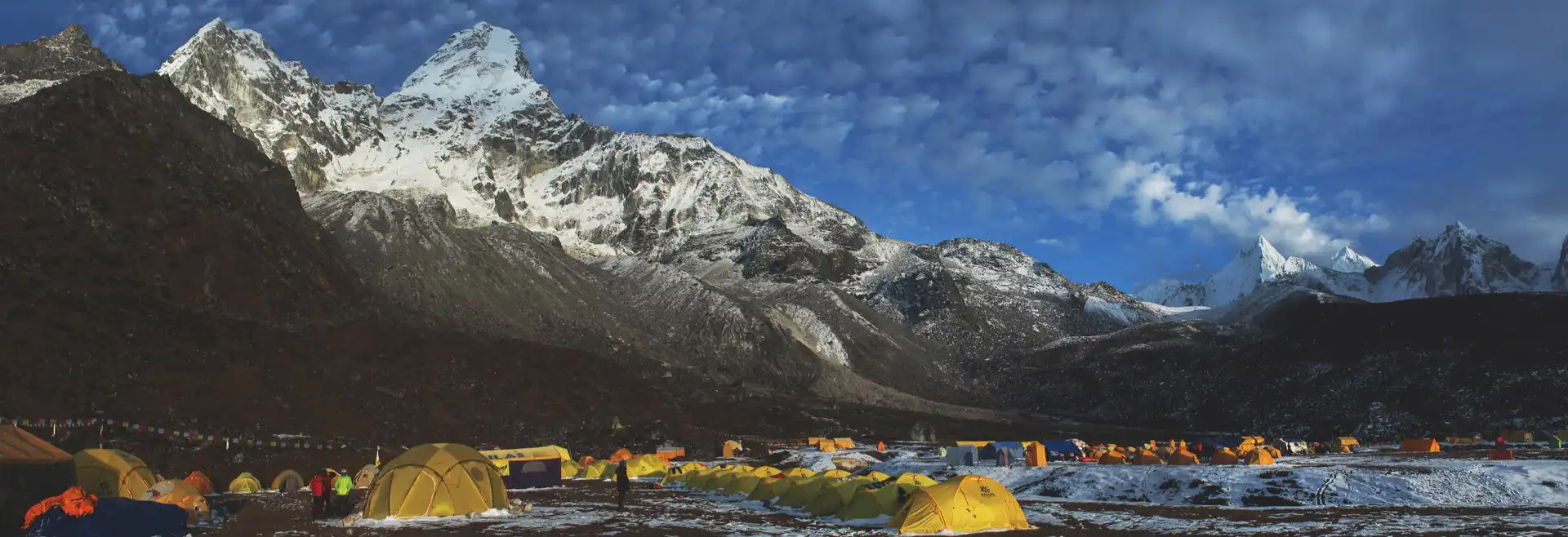
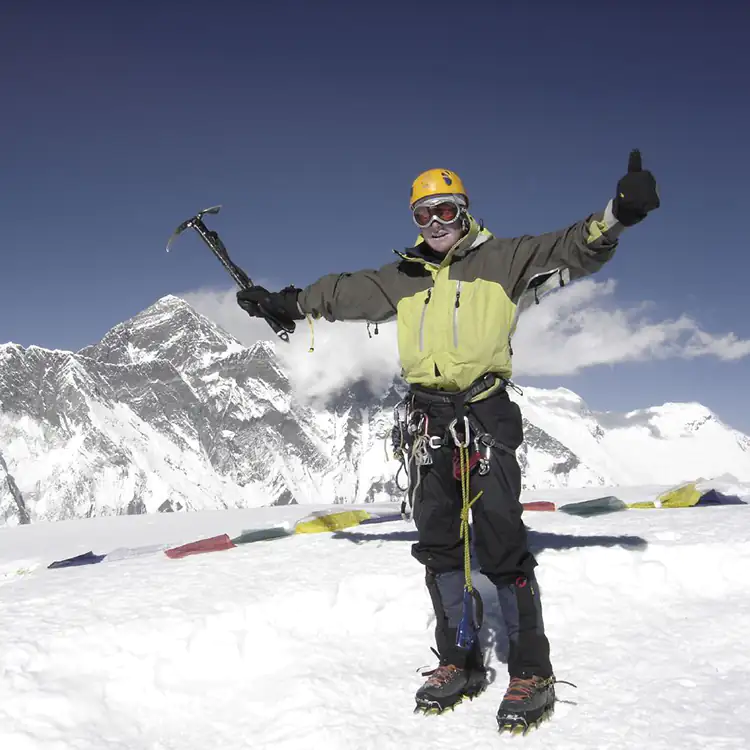
The Ama Dablam Expedition leads adventurers to one of the most iconic and stunning peaks in the Himalayas, Ama Dablam, which stands at a soaring altitude of 6,812 meters. Ama Dablam, known for its distinctive pyramid shape, is a jewel of the Khumbu region and presents a formidable challenge that attracts seasoned climbers from around the globe. Its unique name, “Mother’s Necklace,” beautifully depicts the extended ridges and the hanging glacier, resembling a traditional necklace by Sherpa women.
The mountaineering world celebrates Ama Dablam for its exquisite appearance and technical demands. The mountain’s complex structure requires a versatile set of climbing skills, making it an essential climb for those looking to test their proficiency in mixed rock, snow, and ice terrains. Successfully summiting Ama Dablam is considered a prestigious achievement due to the intricate navigation and high-altitude endurance it demands.
Ama Dablam is a preferred selection by seasoned climbers due to its all-inclusive alpine climbing adventure that takes place in the shortest time possible. Unlike long expeditions necessary for taller peaks, the Ama Dablam expedition has climbers fully involved with advanced technical climbing and high-altitude thrills without the lengthy time frame associated with 8000-meter giant mountain tours. This particular peak presents both physical challenges for mountaineering enthusiasts and the spectacular outlook of the Everest area.

A climber takes a break at Camp 1 during the Ama Dablam Expedition, surrounded by majestic snow-capped Himalayan peaks.
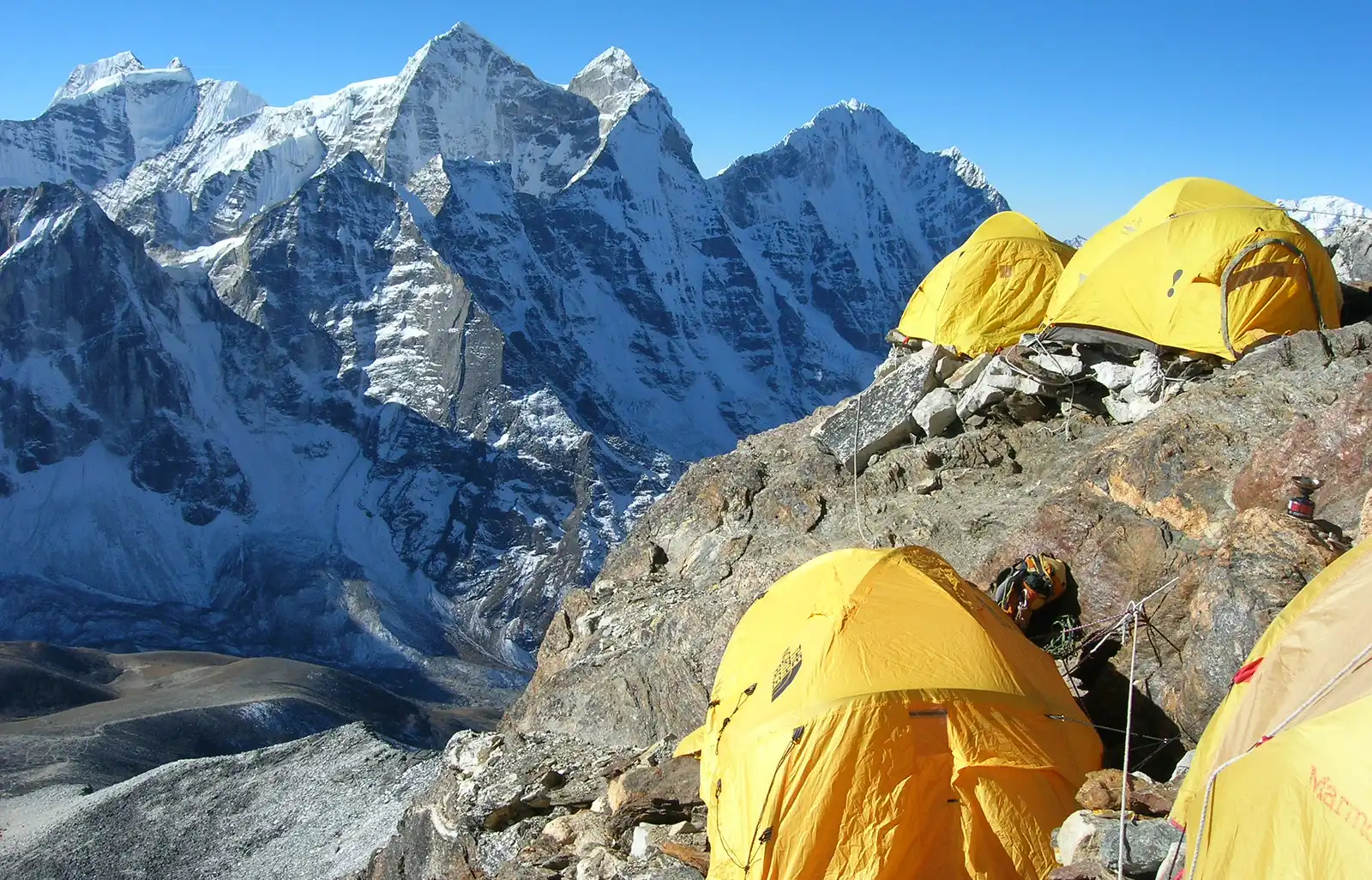
Climbers set up camp at Camp 2 during the Ama Dablam Expedition, surrounded by awe-inspiring snow-covered Himalayan peaks.
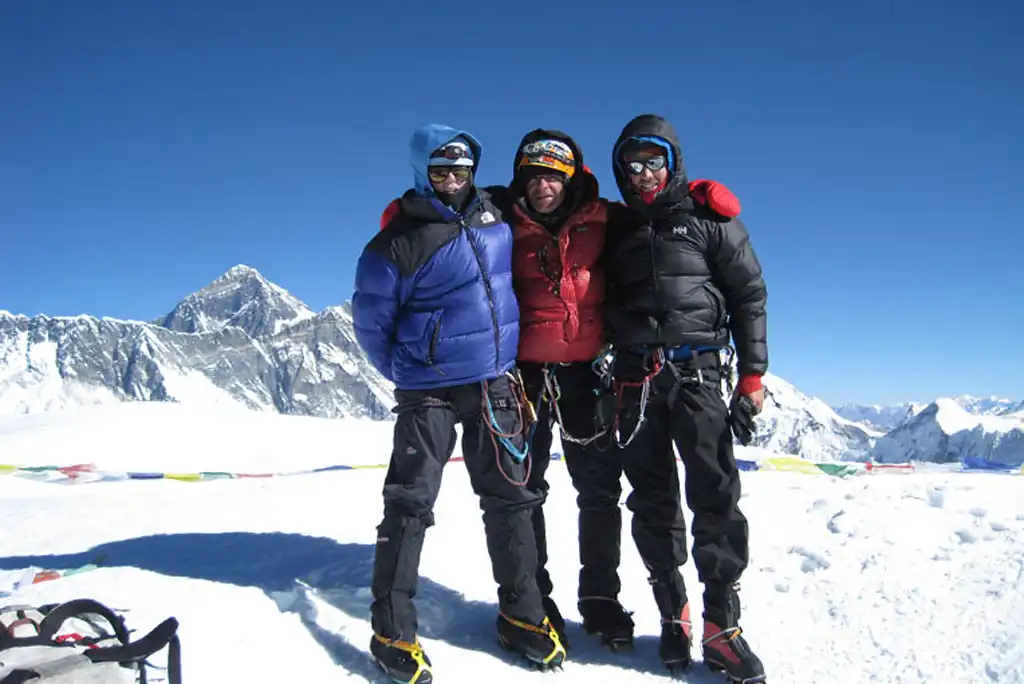
Climbers celebrate their successful ascent as they stand on the summit of Ama Dablam, surrounded by panoramic views of the Himalayan peaks.
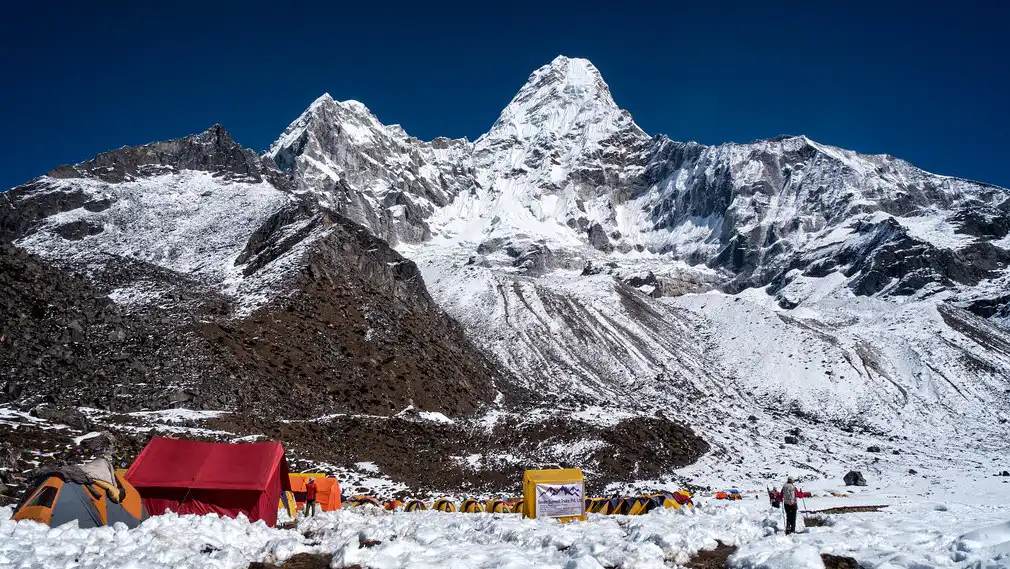
Climbers prepare for their ascent at Ama Dablam Base Camp, surrounded by the breathtaking beauty of the snow-capped Himalayan peaks.
When you arrive at Tribhuvan International Airport, Peregrine Treks and Tours representatives will warmly greet you and escort you to your hotel, officially marking the start of your Ama Dablam Expedition. Nestled at 1,400 meters, Kathmandu combines rich heritage with modern comforts, offering a welcoming start.
After settling in, you will participate in a detailed briefing covering the Ama Dablam Expedition. This critical session will address the itinerary, safety procedures, and gear preparations, ensuring you’re ready for the climb.
Your first night in Kathmandu will be spent in a comfortable hotel, providing essential rest before the expedition’s upcoming challenges.
Accommodation: The Everest Hotel
Meals: Not Included
Spend the day exploring Kathmandu’s UNESCO World Heritage sites, such as Swayambhunath (Monkey Temple) and Pashupatinath Temple. These visits offer a glimpse into Nepal’s rich culture and history, adding depth to the Ama Dablam Expedition experience.
In the afternoon, complete the final preparations for the Ama Dablam Expedition. It includes obtaining necessary permits and ensuring all logistical details are in place for the climb.
After a productive day, enjoy a relaxing evening and overnight stay at your hotel in Kathmandu, preparing for the trek ahead.
Accommodation: The Everest Hotel
Meals: Not Included
In the Ama Dablam Expedition, there’s an early morning flight to Lukla at an altitude of 2860m. The flight is about 30 minutes long and gives you stunning views of the Himalayas, including Everest.
As soon as you land, it marks the beginning of the adventure of trekking through Sherpa villages and using suspension bridges with prayer flags along them.
Trekking towards Phakding will observe a shift from lush green scenery into rocky mountains within 3 – 4 hours of trekking effort that takes place before one arrives at Phakding (2630m).
The teahouse is where one can rest for the night, which, however, should be cheerful because of its hospitality and the scenic beauty surrounding it ahead of more demanding days ahead.
Accommodation: Local Lodge
Meals: Breakfast, Lunch, Dinner
The next stage of your Ama Dablam Expedition takes you from Phakding to Namche Bazaar. The trail follows the Dudh Koshi River, with several high-suspension bridges offering spectacular views of the deep valley below.
You will pass through small villages like Monjo, where you’ll officially enter Sagarmatha National Park. The trail becomes steeper as you continue, especially during the final ascent to Namche Bazaar (3,440 meters). This climb rewards you with your first distant views of Everest and Ama Dablam.
Namche Bazaar is a lively Sherpa town, and your acclimatization begins here. You’ll stay overnight at a teahouse, where the comforts of life in the city help prepare you for the upcoming expedition challenges.
Accommodation: Local Lodge
Meals: Breakfast, Lunch, Dinner
Explore Namche Bazaar, a lively Sherpa town at a high altitude, to acclimate to the altitude. Situated at 3440m above sea level, Namche features various shops, cafes, and local markets that introduce you to Sherpa culture. Why not walk around town during the day, enjoying its beautiful mountain scenery?
The Everest View Hotel is another option for adding more acclimatization. It is just a short hike from here, and from there, you can see amazing views of Everest, Lhotse, and the Ama Dablam mountains. You could also visit the Sherpa Museum to learn about its traditions and mountaineering history.
One can relax at homey teahouses in Namche Bazaar and unwind after exploring for a few hours. These activities help the body acclimate and ensure one is fit enough for other aspects of the Ama Dablam Expedition.
Accommodation: Local Lodge
Meals: Breakfast, Lunch, Dinner
The trek from Namche Bazaar to Tengboche takes about 5 to 6 hours, with the trail first descending to the Dudh Koshi River. You’ll cross suspension bridges and pass through beautiful rhododendron forests.
The route also leads you past mani stones inscribed with Buddhist prayers, adding a spiritual element to your day. As you ascend towards Tengboche, the landscape opens up, revealing breathtaking views of the Himalayan peaks.
Tengboche Monastery, one of the most important in the region, awaits at the end of the trek. You can take time to visit the monastery, enjoy its peaceful atmosphere, and observe the spiritual practices of the monks.
With Ama Dablam and Everest as a stunning backdrop, the serene surroundings of Tengboche Monastery create an inspiring experience. After exploring, settle into your teahouse in Tengboche for a restful night, preparing for the next phase of the Ama Dablam Expedition.
Accommodation: Local Lodge
Meals: Breakfast, Lunch, Dinner
The trek from Tengboche to Pangboche takes about 2 to 3 hours, with the trail winding through lush forests and open meadows. The constant views of the Himalayan peaks make the trek visually rewarding. As you approach Pangboche, the landscape shifts to a more rugged and remote setting, indicating deeper entry into the Khumbu region.
Upon reaching Pangboche (3,930 meters), visit Pangboche Monastery, the oldest monastery in the Khumbu region. This spiritual site holds great cultural significance for the Sherpa community and provides a serene atmosphere amid the mountains.
Pangboche serves as a critical acclimatization stop in this part of Nepal before the climb to higher elevations. You’ll visit the monastery and wander through the little old community before resting at a local teahouse, which is essential if you want to continue trekking toward the Ama Dablam Base Camp.
Accommodation: Local Lodge
Meals: Breakfast, Lunch, Dinner
The trek from Pangboche to Ama Dablam Base Camp is significant to your Ama Dablam Expedition. The trail ascends gradually, with the altitude becoming more noticeable as you approach the base camp. The landscape becomes more rugged, and Ama Dablam’s distinct ridges come into closer view.
After about 4 to 5 hours of trekking, you will arrive at Ama Dablam Base Camp at 4,600 meters. This camp will be your base for the upcoming climb. Surrounded by dramatic mountain scenery, the camp offers a close-up view of the peak and its surroundings.
Once you settle into the base camp, you will focus on acclimatization, preparation, and planning for summit attempts. The days ahead will include acclimatization hikes and final gear checks. You’ll sleep in tents at the bottom of the mountain and prepare for climbing.
Meals: Breakfast, Lunch, and Dinner
Accommodation: Tented Camp
The climbing period of the Ama Dablam Expedition spans several days, during which the team focuses on acclimatization, technical training, and preparing for summit attempts. Establishing higher camps is crucial, with Camp 1 positioned at 5,700 meters. Climbers practice essential skills on the mixed rock and snow terrain during this stage, preparing for the challenges ahead.
After resting and adjusting at Camp 1, the team advances to Camp 2, 6,200 meters. The route to Camp 2 introduces steeper and more technical sections, including rock towers and icy ridges. Climbers use fixed ropes to navigate these demanding parts, making this phase crucial for preparing for the final ascent.
Summit day represents the most challenging part of the Ama Dablam Expedition. The ascent from Camp 2 to the Ama Dablam Summit (6,812 meters) requires navigating steep rock faces and snow-covered ridges. Climbers tackle significant technical obstacles, such as the famous “Yellow Tower” and exposed ridgelines.
Climbers who reach the Ama Dablam Summit enjoy incredible panoramic views of Everest, Lhotse, and other towering Himalayan peaks. After briefly enjoying the summit, climbers begin carefully descending back to the lower camps.
After a successful summit, the descent to base camp takes several days. Climbers return through the established camps, ensuring rest and recovery at each stage to avoid fatigue and altitude issues.
The team celebrates the expedition’s success when safely back at Ama Dablam Base Camp. The overnight stays at various camps throughout the climbing period are crucial in maintaining climbers’ energy and ensuring a safe and successful completion of the Ama Dablam Expedition.
Meals: Breakfast, Lunch, and Dinner
Accommodation: Tented Camp
Pack up your gear at Ama Dablam Base Camp and descend toward Pangboche. The familiar trail allows you to reflect on your accomplishments during the expedition.
The descent takes approximately 4 to 5 hours and leads you back to Pangboche at 3,930 meters. Once there, relax in a cozy teahouse, offering a well-deserved rest after the intense climbing days.
Accommodation: Local Lodge
Meals: Breakfast, Lunch, Dinner
Begin your descent from Pangboche to Namche Bazaar, taking about 5 to 6 hours. The trail gradually eases, leading you through beautiful forests and charming Sherpa villages.
Reaching Namche Bazaar at 3,440 meters feels like a significant milestone, and you can celebrate the success of your Ama Dablam Expedition with your team. Relax in a comfortable teahouse, enjoying the lively atmosphere of Namche for the evening.
Accommodation: Local Lodge
Meals: Breakfast, Lunch, Dinner
Your final stretch is a downward hike lasting 6 – 7 hours from Namche Bazaar to Lukla. The path will take you through thick forests with suspension bridges, reminding you of the beginning stage of your trek.
When you reach Lukla (2,860 meters), it is time to think about the difficulties encountered and victories during the Ama Dablam Expedition. Finally, spend the rest of the day in a tea house in Lukla, preparing for your flight back to Kathmandu.
Accommodation: Local Lodge
Meals: Breakfast, Lunch, Dinner
Start the day with a 30-minute scenic flight from Lukla to Kathmandu, where you’ll catch your final glimpses of the Himalayas from the air. After landing in Kathmandu, a transfer takes you to your hotel, where you can relax or explore the city. This day is perfect for unwinding after the expedition, with plenty of time to enjoy the vibrant capital.
In the evening, rest comfortably at your hotel, reflecting on the completion of your Ama Dablam Expedition. Whether you enjoy a quiet evening or take in more of Kathmandu’s sights, this is your opportunity to relax and celebrate your achievements.
Accommodation: The Everest Hotel
Meals: Not Included
Before proceeding to the airport, there is a chance of jogging or strolling in Kathmandu in the morning. Finally, this is an excellent chance to take home some collectibles or go voyaging to other noteworthy remaining sites about culture.
Once you are ready, you will make your way out of Tribhuvan International Airway. Because this is the ending of any Ama Dablam Exploration, Nepal remains etched in your mind forever due to the experience gained from the Himalayas. May it be safe travels and equally fulfilling for your destination next time round?
Meals: Breakfast
The ideal seasons for the Ama Dablam Expedition are the pre-monsoon period (April to early June) and the post-monsoon season (late September to November). These periods bring favorable weather conditions with clear skies, moderate temperatures, and minimal rainfall.
Pre-Monsoon Season (April to Early June): During the pre-monsoon season, stable weather conditions make this a prime time for the Ama Dablam Expedition. Climbers enjoy moderate temperatures, clear views, and fewer crowds on the trail.
With longer days, you have more daylight for trekking and climbing, allowing for a smoother ascent. The predictability of snow and ice conditions adds to the appeal, making this period highly recommended for a successful expedition.
Post-Monsoon Season (Late September to November): After the monsoon rains, the post-monsoon season offers another excellent window for the Ama Dablam Expedition. The crisp and cool air provides excellent visibility for photographers and climbers.
This period tends to be less crowded, creating a more serene environment. Temperatures can significantly drop as winter approaches higher altitudes, making acclimatization and preparation crucial for climbers.
Weather is necessary for climbing Ama Dablam. Choosing stable weather during pre- and post-monsoon seasons minimizes risks like avalanches and unpredictable storms. Monitoring forecasts and adjusting your plans based on changing conditions can be the difference between a safe climb and facing unnecessary dangers.
Understanding the seasonal impact also helps climbers gauge the Ama Dablam Difficulty level. Favorable weather makes technical challenges more manageable, while extreme conditions increase the complexity of the climb. Additionally, the Ama Dablam Expedition cost may vary depending on the season, as peak periods can drive up expenses for permits, logistics, and support teams.
The Ama Dablam Expedition takes climbers along a challenging and scenic route through the Khumbu Valley, starting with a trek from Lukla to Ama Dablam Base Camp at 4,600 meters. From base camp, climbers begin the ascent by setting up higher camps and navigating technical terrain.
The Ama Dablam Expedition is renowned for its technical challenges. Climbers need strong rock, ice, and mixed climbing skills to navigate steep rock faces like the Yellow Tower near Camp 2. Narrow ridges and exposed snow sections, particularly on Mushroom Ridge, add to the difficulty, making this climb highly technical.
Proper preparation is vital for a safe and successful Ama Dablam Expedition. Climbers must meet specific physical and technical requirements while ensuring they have the correct gear for one of the Himalayas’ most demanding peaks.
Excellent fitness is required to withstand the steep topography and altitude of an actual ama dablam trekking expedition. Burnishing endurance levels, muscular endurance, and cardiovascular fitness are critical.
Regular aerobic exercises like running or cycling should accompany strength training routines to improve stamina. Hiking with weighted backpacks for long distances helps you condition yourself for what the trip will demand, while flexibility exercises such as yoga help prevent injuries.
Climbing Ama Dablam requires advanced technical skills. Climbers need rock and ice climbing proficiency and experience using crampons and ice axes.
Mastering fixed rope techniques and basic mountaineering skills like self-arrest and crevasse rescue is crucial. Specialized mountaineering courses can help develop these skills, ensuring you’re ready for the technical challenges ahead.
The right gear is essential for a successful Ama Dablam Expedition. Here’s an essential checklist:
Reaching the Ama Dablam Summit at 6,812 meters is a remarkable feat. Climbers can enjoy breathtaking panoramic views of Everest, Lhotse, Makalu, and the surrounding Himalayas. The vast expanse of snow-capped peaks under the clear sky makes this moment unforgettable, marking a true highlight of the Ama Dablam Expedition.
You can enjoy a 360-degree view of the iconic Himalayan range from the summit. Ama Dablam Peak’s majestic pyramid shape adds to its grandeur, making this vantage point truly special.
As climbers make their way up the steep slopes and along narrow ridges, they must always remain focused, which will save their lives if something goes wrong. They should also use fixed ropes properly while moving calmly at a regular pace lest they lose balance or fall off the mountain at times.
Suppose there is no proper adaptation made before one starts climbing high altitudes. In that case, they can quickly get high altitude sickness besides managing to know weather changes, thus avoiding getting caught by sudden storms. During this last stretch of the trek, team members should communicate clearly to be safe.
The Ama Dablam Expedition cost typically includes several vital expenses, such as permits, guide fees, logistics, and equipment. Knowing these costs upfront helps climbers budget effectively and plan for a successful expedition.
Climbing Ama Dablam involves significant risks, so careful planning is essential to ensure safety.
The dangers associated with Ama Dablam include snow slips, rock slides, and mountain sickness. Correct acclimatization and evading tricky cyclone weather can keep these at bay. Safeguarding oneself from falling stones does not exclude headgear or loops around your body.
An experienced guide enhances safety by navigating challenging terrain and making informed decisions. Sherpas and support staff assist with logistics, carry loads, and set up camps, ensuring you are well-prepared.
A clear evacuation plan is crucial in emergencies, such as injuries or severe altitude sickness. Helicopter evacuations and ground rescues should be part of the expedition’s emergency protocol. Carrying a first aid kit and maintaining communication with the base camp ensures timely assistance in critical situations.
Many experienced mountaineers from around the world have climbed Ama Dablam. Notable climbers include professionals like Sir Edmund Hillary and Tenzing Norgay, who, although more famous for summiting Everest, have also taken on the peak. Due to its technical challenges, the peak attracts those with significant climbing experience.
The Ama Dablam Expedition costs typically range from $6,000 to $10,000. This price covers permits, guide fees, logistics, and equipment. Costs vary depending on the season, support level, and expedition company. You should also factor in additional expenses like travel insurance and personal gear.
Ama Dablam is one of the most complicated mountains to climb in the Himalayas. Climbers encounter steep rock faces, exposed ridges, and ice strides that call for improved mountaineering skills. Because of the rocky terrain and technical obstacles, it is much more challenging than many other peaks in this mountain range.
The Ama Dablam Expedition Nepal is an organized climb to the summit of Ama Dablam, a striking peak in the Khumbu region. The expedition typically lasts 25-30 days, including trekking to Ama Dablam Base Camp, acclimatization, and summit attempts. It is known for its technical difficulty and stunning views of Everest and the surrounding region.
Beginners should avoid Ama Dablam, as climbers need experience in high-altitude mountaineering, rock climbing, and ice climbing. Proficiency with crampons, ice axes, and fixed ropes is essential. Beginners should build experience on less technical peaks before attempting Ama Dablam.
Dablam’s visually arresting pyramid-like form has earned it a place among Earth’s loveliest mountain peaks. Due to its notable height and technical difficulty, Khumbu region’s Amadablam attracts seasoned climbers.
It also sits on top of Everest and may be viewed with other towering Himalayas, thus enhancing its prestige among mountain climbers who have ventured there.
